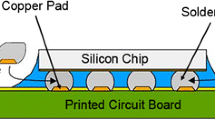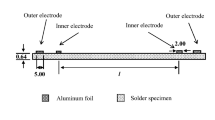Abstract
The electrical resistivity of soft solder (Pb0.28Sn0.72) has been measured in the temperature range 4.2 K to 300 K. The ‘alloy’ becomes electrically superconducting at a temperature of 6.9 K. Above this, in the entire temperature range, the resistivity could be described, apart from the residual resistivity, by the weighted average of the resistivities of the individual constituents which are derived from the Bloch-Grüneisen relation. The results are in accordance with the phase diagram, which shows a co-existence of two phases in almost the entire range of concentration of the Pb-Sn binary system. It has been shown that the thermal conductivity data on soft solder as well as on Pb0.7Sn0.3, both taken from literature, could be interpreted on the same basis, below and above the ‘superconducting transition temperature’. Recent results on other Pb-Sn systems are discussed in the light of this interpretation.
Similar content being viewed by others
References
Berman R, Foster E L and Rosenberg H M 1955Br. J. Appl. Phys. 6 181
Berman R and McDonald 1951Proc. R. Soc. A209 368
Chandrasekaran S, Hariharan Y, Radhakrishnan T S and Subramanian V 1979 (to appear inCryogenics)
Chuah D G S, Ratnalingam R and Seward R J 1978J. Low. Temp. Phys. 31 153
Dwight E G (ed) 1972American Institute of Physics Handbook (New York: McGraw Hill)
Hansen M 1958Constitution of binary alloys (New York: McGraw Hill)
Harper C A 1972Handbook of wiring, cabling and interconnecting for electronics (New York: McGraw Hill)
Karamargin M C, Reynolds C A, Lipschutz F P and Klemens P G 1972Phys. Rev. B5 2856
McDonald D K C 1956 inHandbuch der Phys. (ed. Flugge) Vol. 14
Meaden G T 1965Electrical resistance of metals (New York: Plenum)
Mendelssohn K 1964 inProgress in low temperature physics ed. C J Gorter (Amsterdam: North Holland) Vol. 1
Mendelssohn K and Olsen J L 1950Proc. Phys. Soc. A63 2
Radhakrishnan T S, Hariharan Y and Janawadkar M P 1979 (to be published)
Rosenberg H M 1955Philos. Trans. R. Soc. (London) 247 441
Wilson A H 1953Theory of metals (Cambridge: University Press)
White G K 1968Experimental techniques in low temperature physics (Oxford: Clarendon Press)
Author information
Authors and Affiliations
Rights and permissions
About this article
Cite this article
Hariharan, Y., Janawadkar, M.P. & Radhakrishnan, T.S. Electrical and thermal conductivity of soft solder at low temperatures. Pramana - J. Phys. 13, 117–125 (1979). https://doi.org/10.1007/BF02872130
Received:
Issue Date:
DOI: https://doi.org/10.1007/BF02872130




